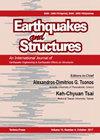圆柱摩擦阻尼器对建筑物地震渐进倒塌的抑制作用
IF 1.4
4区 工程技术
Q3 ENGINEERING, CIVIL
引用次数: 1
摘要
由于火灾或地震导致结构中竖向承重单元的移除而引起的递进式倒塌,一直是结构工程师面临的重大挑战。渐进性倒塌被定义为结构部分的完全破坏或破坏,始于建筑物部分的局部破裂,并可能威胁到结构的稳定性。在目前的研究中,考虑圆柱摩擦阻尼器结构在消除竖向承重单元时的两种情况:1 .承重单元在重力荷载作用下被移除;2 .承重单元由于地震侧向力而被移除。为了在地震情况下得到一个广义的结果,将FEMA p695中给出的22对运动应用于结构。该研究使用了案例(1)的垂直向下推分析,并使用OpenSEES软件对5层、10层和15层钢框架的第二个案例进行了非线性时程分析。结果表明,在第一种情况下,安装圆柱摩擦阻尼器的结构的载荷系数和强度都有较大的提高;此外,第二种情况的结果表明,在安装圆柱形摩擦阻尼器的建筑物中,位移和施加给结构的力大大减少。在摩擦阻尼器中定义了最佳滑移载荷,该载荷允许阻尼器从该阈值载荷开始其摩擦阻尼。因此,对两种情况下阻尼器的最佳滑移载荷进行了计算和讨论。本文章由计算机程序翻译,如有差异,请以英文原文为准。
Seismic progressive collapse mitigation of buildingsusing cylindrical friction damper
The occurrence of progressive collapse induced by the removal of the vertical load-bearing element in the structure, because of fire or earthquake, has been a significant challenge between structural engineers. Progressive collapse is defined as the complete failure or failure of a part of the structure, initiating with a local rupture in a part of the building and can threaten the stability of the structure. In the current study, the behavior of the structures equipped with a cylindrical friction damper, when the vertical load-bearing elements are eliminated, is considered in two cases: 1-The load-bearing element is removed under the gravity load, and 2-The load-bearing element is removed due to the earthquake lateral forces. In order to obtain a generalized result in the seismic case, 22 pair motions presented in FEMA p 695 are applied to the structures. The study has been conducted using the vertical push down analysis for the case (1), and the nonlinear time-history analysis for the second case using OpenSEES software for 5,10, and 15-story steel frames. Results indicate that, in the first case, the load coefficient, and accordingly the strength of the structure equipped with cylindrical friction dampers are increased considerably. Furthermore, the results from the second case demonstrate that the displacements, and consequently the forces imposed to the structure in the buildings equipped with the cylindrical friction damper substantially was reduced. An optimum slip load is defined in the friction dampers, which permits the damper to start its frictional damping from this threshold load. Therefore, the optimum slip load of the damper is calculated and discussed for both cases.
求助全文
通过发布文献求助,成功后即可免费获取论文全文。
去求助
来源期刊

Earthquakes and Structures
ENGINEERING, CIVIL-ENGINEERING, GEOLOGICAL
CiteScore
2.90
自引率
20.00%
发文量
0
审稿时长
>12 weeks
期刊介绍:
The Earthquakes and Structures, An International Journal, focuses on the effects of earthquakes on civil engineering structures. The journal will serve as a powerful repository of technical information and will provide a highimpact publication platform for the global community of researchers in the traditional, as well as emerging, subdisciplines of the broader earthquake engineering field. Specifically, some of the major topics covered by the Journal include: .. characterization of strong ground motions, .. quantification of earthquake demand and structural capacity, .. design of earthquake resistant structures and foundations, .. experimental and computational methods, .. seismic regulations and building codes, .. seismic hazard assessment, .. seismic risk mitigation, .. site effects and soil-structure interaction, .. assessment, repair and strengthening of existing structures, including historic structures and monuments, and .. emerging technologies including passive control technologies, structural monitoring systems, and cyberinfrastructure tools for seismic data management, experimental applications, early warning and response
 求助内容:
求助内容: 应助结果提醒方式:
应助结果提醒方式:


